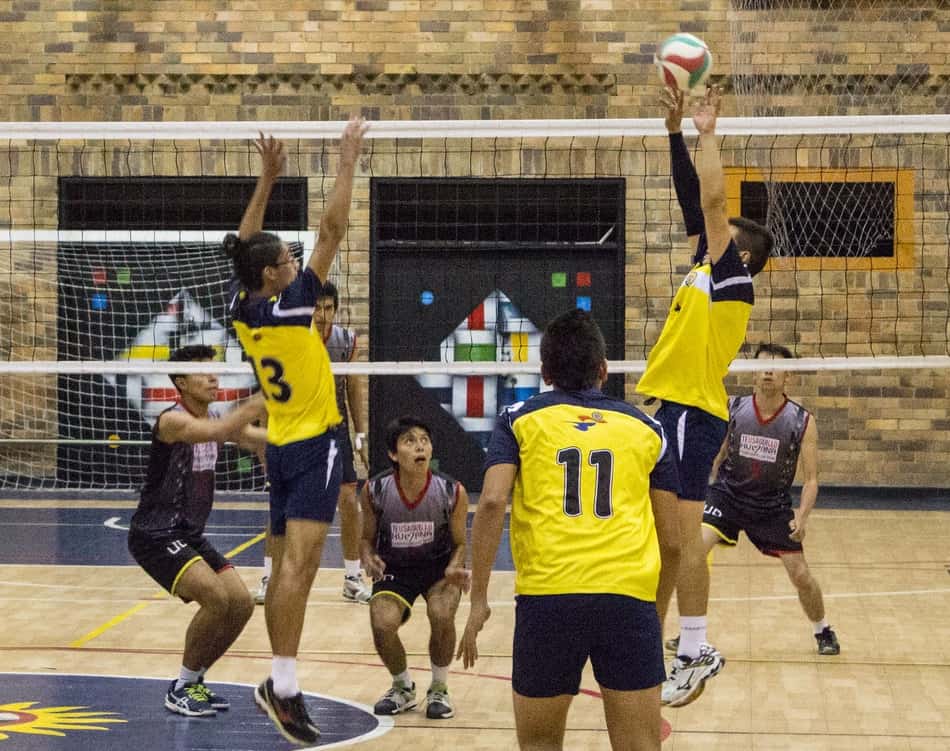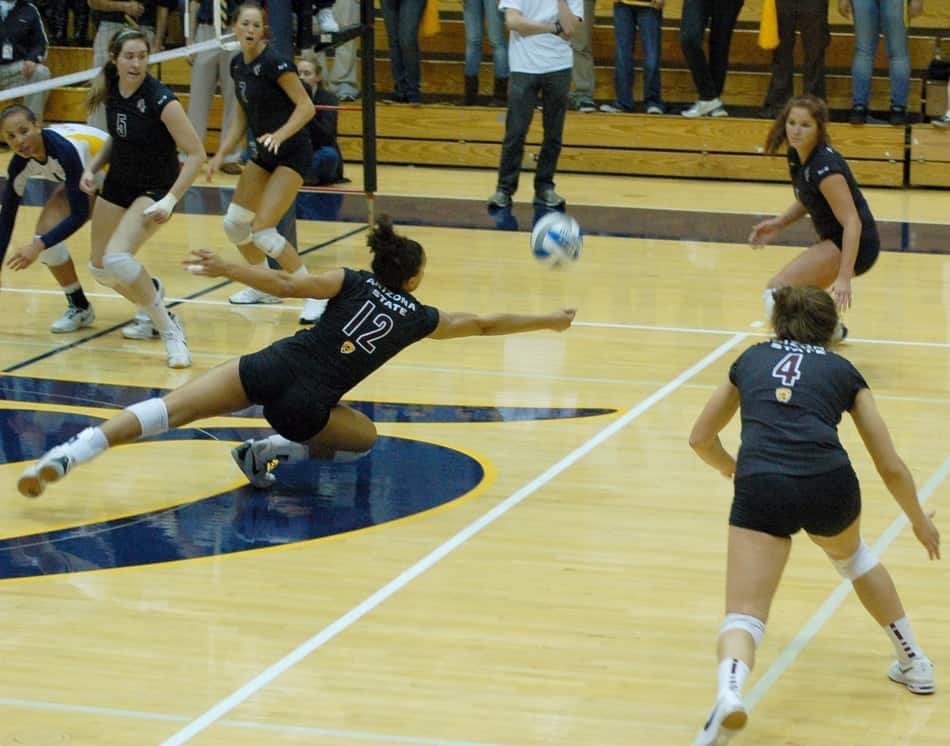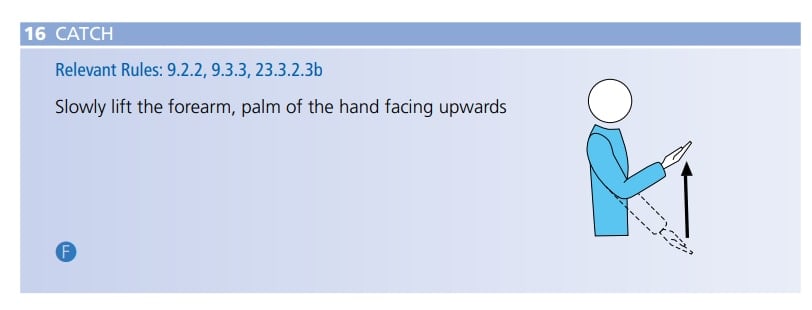Volleyball has many different rules and some of them can be fairly difficult to pick up on if you’re just a casual fan. Sometimes the call comes from the referee so quickly it can be frustrating to try to understand why your team just lost a point.
What is considered a carry in volleyball? In volleyball, a carry is when a player has extended contact with the ball. This can be during any type of hit if it’s not a clean, quick contact.
Some people think you can only be called for a carry when you’re volleying the ball, but that’s not correct. If you read below, I’ll give you an example of a “carry” being called in each kind of contact with the ball.

Carrying During A Volley
The ball is not allowed to be caught or thrown (FIVB Volleyball Rules section 9.2.2). It can often be a fine line between a volley and a catch and throw. Referees are trained to be able to consistently decide when a player has had too long of contact through the volleying motion and it crosses into the line of being a “catch and throw.”
When you’re volleying, it’s important that you don’t “possess” the ball for more than a quick fluid motion. You want your hands to quickly absorb the incoming ball and in one non-stop motion, flick it back out. When a player struggles and extends that time just a little, they’re going to get called for it very quickly.
Carrying During A Pass
Usually, when there’s an extended contact with the ball during a pass or an underhand strike it’s called a lift. Really a lift and a carry are breaking the same rule, the fact that your contact is supposed to be a clean, momentary contact with the ball.
This can be with a two-hand platform pass if the player is trying to swing their arms and they don’t time it properly. The tip here is, DON’T SWING YOUR ARMS! Did I sound like your coach? Your arms should create a platform and you let your legs drive the pass if you need more power.
Carrying During The Attack

Sometimes players are called for a carry during an attack. The rules describe an attack as any hit that directs the ball towards your opponents. When attacking, players may tip, but the ball has to be “cleanly hit” and not “caught or thrown” (Rules Section 13.1.2).
When players drag the ball through the air it becomes less of a tip, hit or spike, and more of a throw. Often this can be avoided by being careful of your hand placement. If your hand is under or behind the ball it’s much more likely you’ll be called for a carry than if your hand is coming overtop.
Carrying During A Save
During a one-armed save, all bets are off! We’re in desperation mode, scrambling and diving for the ball. It’s pretty common when we’re lunging like this to make all kinds of errors.
Just remember that whichever way you’re facing, no matter how twisted-around you are or how far you have to send the ball, you’ve got to hit it with a “pop.” When you make a clean strike you’re going to get the ball further anyways, which is usually what you’re trying to do.

Can You Carry The Ball During A Serve?
In the lower age groups, when underhand serving is common, you may see a carry called during the serve. Although the referee may not actually call it a “carry” exactly, the servers may sometimes move their hand that’s holding the ball and use their striking hand as more of an underhand throw.
If you see a player struggling with this, help them work on the proper mechanics. They will be so much more successful if they strike the ball, delivering a pop or a punch contact to it, than if they kind of drag the ball into motion.
The actual, technical call for this is “Ball not tossed or released at the service hit.” The hand signal will look like the “catch” sign, only the referee will keep their arm straight instead of bending at the elbow.
For tips learning or teaching the underhand serve, check out How To Serve A Volleyball Underhand.
How Can You Tell The Call Was “A Carry?”
In volleyball, multiple faults or rules violations may share the same hand signals from the refs. In the case of a carry, the referee will usually signal it the same as a lift, but the official name of the fault is a “catch.”
The referee will blow the whistle dead and extend their arm down toward the floor with their palm facing upward, and then raise the hand bending at the elbow.

The other way a carry may be signaled is during an attack, if the referee deems the contact to be a carry, they may signal an “attack hit fault.” This hand signal will look more like a slow-motion spike.
This is actually an incorrect (but unfortunately common) mistake by referees because it seems strange to do the hand motion pictured above when the player looked like they were spiking or tipping. The correct signal would still be the one shown above for a “catch” violation.
Multiple Hits At A Time
A common time for players to be called for a carry is when there are multiple people rushing to hit the ball and they make contact together or one right after another in a split-second. The speed and/or confusion can make it hard to decipher what happened and if the hits were legal.
The rules allow for all kinds of hits with different body parts, but they have to be simultaneous. Meaning if you hit the ball with 2 hands, it has to happen at the same time, with the same motion. If you and another player (or even 3 players total) hit the ball, you can hit it all simultaneously and it will be legal, but it will count as multiple hits (Rules Section 9.2.3.1).
Is A Power Tip A Carry?
The rules in volleyball are pretty simple and clear. They don’t distinguish a tip from a “power tip” in the written list of legal or illegal hits.
In the volleyball world, a power tip is an attack that’s somewhere between a tip and a spike. It’s a forward and downward dumping motion, but usually, it’s a lot softer than the strike you would have with a traditional spike.
So is it legal or is it a carry? Well, that’s up to the referee. Some calls can be very subjective and really depends on your interpretation of the rules.
In my experience, most refs will let one or two questionable “power tips” go, but if the same hitter is doing it over and over again, they may start to call it a carry. I guess it’s human nature that once you’ve seen it a few times and you’re watching for it, you probably get pickier if you think the rules are being stretched.
Are there other volleyball terms and lingo that you hear that don’t make sense to you? Check out our post all about volleyball terms.
References:
Official FIVB Rules: https://www.fivb.com/en/volleyball/thegame_glossary/officialrulesofthegames
Photo Credits:
Feature image by Cuatto Volley Giaveno on flickr.com: https://creativecommons.org/licenses/by/2.0/
Volley image by Sweet Spot on flickr.com: https://creativecommons.org/publicdomain/mark/1.0/
Beach player image by hamperium from Pixabay.
Save image by Ron Hall on flickr.com: https://creativecommons.org/licenses/by/2.0/
Recent Posts
Athletes, listen up! Do you have a closet full of old jerseys, sweatpants, and tees that you just can't seem to part with? Well, dust them off, because you're sitting on a goldmine of fashion...
You may have heard, or you may have noticed, that there's been a change to the rule about double contact in volleyball. In 2022, an experimental rule change began to be implemented, where the double...
